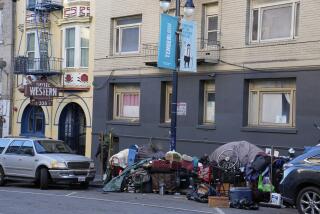City’s Homeless Program Hankers for Independence
VENTURA — Born from the floods that washed out more than 100 squatters living in the Ventura River bottom, the city’s award-winning homeless assistance program has spent the last year growing into a fledgling job placement center.
Then it hit those awkward teenage years.
Too young to survive on its own financially, yet eager to take an independent course, the program’s supporters are trying to turn it into a nonprofit organization and wean it from city handouts.
“The umbilical cord isn’t cut, but it is getting stretched,” said Marla Louise Buckert, board chairwoman for the Homeless Employment Resource Operation, or HERO, program. “I think that the city probably doesn’t want to nursemaid us forever.”
By establishing nonprofit status and linking directly with local businesses, program coordinators say HERO can eventually become self-sufficient.
“We would like to move away from government subsidy,” said HERO Executive Director Bob Costello. “We don’t want to become another agency that every year comes back for a decreasing pool of money.”
To ease the transition from city-supported project to autonomous agency, program supporters met Thursday night at Ventura City Hall to encourage community participation.
“We are trying to get community-based support any way that we can,” Costello said. “We really don’t want to be just another agency.”
About 40 residents and community leaders attended the meeting, gathering in small groups to discuss ways to publicize the project and generate money for its continuing operation.
“We sort of look at this group in this room as a brain trust,” said Lauri Flack, president of the Westside Community Council and a member of HERO’s board of directors.
One suggestion was to create a speakers group of men and women who have used the program and could talk to schools, church groups and service clubs about HERO’s value.
The program successfully placed more than 70 former river-bottom residents in permanent housing last year, after violent flood waters destroyed their makeshift camps in January.
In the months that followed, the program also helped secure temporary jobs for more than 25 homeless men and women.
The assistance program was so successful that it won a statewide award last year. City officials learned Thursday that it has now qualified for a national housing award.
“It was a project that was a response to an emergency,” said Loretta McCarthy, a city planner who has worked closely with the program since its inception.
“We really saw the success of that,” she said, “but for ongoing day-to-day needs . . . it makes more sense to have a nonprofit agency.”
The program received $105,000 from the city last year. An additional $56,000 for job training is earmarked in a proposed budget to be considered by the City Council in the coming weeks.
The program is also slated to receive $115,000 in federal funding intended to purchase the 1-acre site where the job placement center is now located.
The HERO center operates out of an old lumberyard on Riverside Drive in west Ventura, just a few miles from where the homeless shantytowns once dotted the river bottom.
The center provides a permanent facility where homeless men and women can take classes in how to apply and interview for jobs. It also serves as a job-referral service and helps provide temporary employment on work crews cleaning up county parks and other areas.
In addition, homeless people who come to the center can get referrals to agencies that provide housing, drug and alcohol counseling and veterans’ services.
“It is a one-stop place for people who are looking for employment, who have been on the streets or close to being on the street,” Costello said.
Beyond the employment opportunities, coordinators say, their program provides something that government agencies lack: an encouraging pat on the back from those who have struggled with the same problems.
“You are treated as an individual--not a number in a file,” said Gifford Seawright Sr., a recovering alcoholic who came to the HERO program a year ago, homeless and jobless. He now works for the center providing job placement assistance.
“I didn’t have two nickels to rub together,” Seawright said, recalling his arrival at the program’s temporary shelter at Camarillo State Hospital last spring. “My whole life was upside-down. I fell in love with this program.”
Some participants have dropped out, but coordinators say they have seen more success stories than failures.
“For being a fairly young agency, we have covered more territory than I expected,” Costello said. “Last July, we didn’t have a place to hang our hat. We were working out of cars.”
But now, he said, the program is helping homeless people find jobs, which in turn enables them to start new lives off the streets.
“This has been a missing link,” he said. “To just keep bouncing people off the detox wall and back into the street just doesn’t work.”
More to Read
Sign up for Essential California
The most important California stories and recommendations in your inbox every morning.
You may occasionally receive promotional content from the Los Angeles Times.









